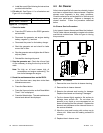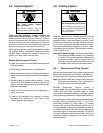
TP-6810 11/13 53Section 4 Scheduled Maintenance
4.7 Ignition System
Service the spark plugs at the interval specified in the
service schedule using the following procedure.
1. Press the OFF button on the RDC2 controller.
2. Disconnect the power to the battery charger.
3. Disconnect the generator set engine starting
battery, negative (--) lead first.
4. Remove spark plug wires by grasping the spark
plug boot and turning slightly while pulling. Do not
pull the wire. Pulling on the wire rather than the
boot may damage the wire or terminal.
5. Loosen the spark plug with a ratchet and 5/8-in.
spark plug socket with a rubber insert to prevent
spark plug damage.
6. Use compressed air to remove dirt from around
each sparkplug to prevent dirtparticles from falling
into the combustion chamber.
7. Remove spark plugs, one at a time, and examine.
Identify a normal spark plug in good operating
condition by observing a light tan or gray deposit on
firing tip. See Figure 4-9 to evaluate engine
condition bycolor/condition of aproblem spark plug.
8. Clean spark plugs by wiping them with a rag. File
the center electrode to keep it parallel to the side
electrode.
Note: Do not sandblast, wire brush, scrape, or
otherwise service spark plugs in poor
condition. Obtain a new plug for best
results.
9. Check the spark plug gap before installing any
spark plug. See Figure 4-7 and Figure 4-8. Attain
a correct gap when the feeler (or wire) passes
between the spark plug electrode. It should pass
easily but with some resistance or drag; otherwise
adjust as necessary.
Model Spark plug gap
38 RCL, 48RCL, and 60RCL 0.9 mm (0.035 in.)
Figure 4-7 Recommended Spark Plug Gap
1-514
1
2
1. 0.9 mm (0.035 in.) gap
2. Spark plug electrodes
Figure 4-8 Spark Plug Gap Inspection
Problem/Condition Means of Identification Possible Cause/Solution
Gap-bridged spark
plug
Built-up deposits and gap between electrodes
closing.
Oil or carbon fouling. Clean and regap the spark
plug.
Oil-fouled spark plug Wet, black deposits on the insulator shell, bore,
and electrodes.
Excessive oil entering combustion chamber
through worn rings and pistons, excessive
clearance between valve guides and stems, or
worn or loose bearings. Replace the spark plug.
Carbon-fouled spark
plug
Black, dry, fluffy carbon deposits on insulator
tips, exposed shell surfaces and electrodes.
Incorrect spark plug, weak ignition, clogged air
intake, overrich fuel mixture, or excessive
no-load operation. Clean and regap the spark
plug.
Lead-fouled spark plug Dark gray, black, yellow, or tan deposits; or a
glazed coating on the insulator tip.
Caused by highly leaded fuel. Replace the
spark plug.
Pre-ignition damaged
spark plug
Melted electrodes and possibly blistered
insulator. Metallic deposits on i nsulator suggest
internal engine damage.
Wrong type of fuel, incorrect timing or advance,
too hot a plug, burned valves, or engine
overheating. Replace the spark plug.
Overheated spark p lug White or light gray insulator with small black or
gray/brown spots with bluish (burned)
appearance on electrodes.
Engine overheating, wrong type of fuel, loose
spark plugs, too hot a plug, low fuel pressure or
incorrect ignition timing. Replace the spark plug.
Worn spark plug Severely eroded or worn electrodes. Caused by normal wear and failure to replace
spark plug at prescribed interval. Replace the
spark plug.
Figure 4-9 Engine Evaluation Using Spark Plug Condition


















